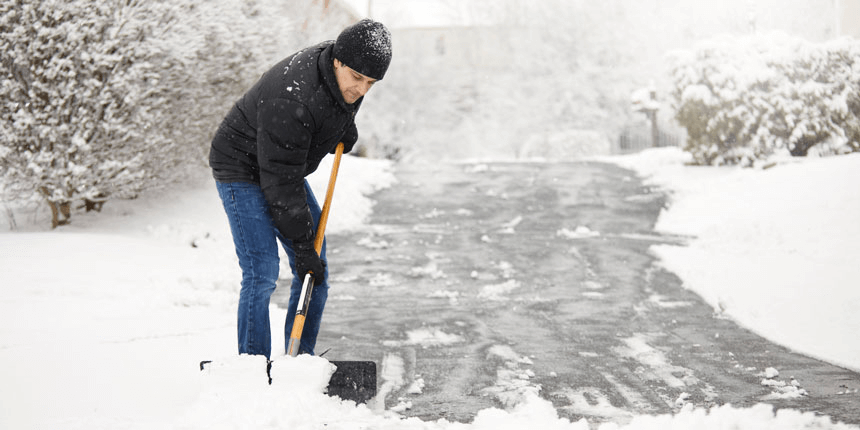Shoveling snow is a common winter job for a lot of people, but it might come with unexpected hazards for heart wellness. Although shoveling is an effective physical exercise, it also strains the circulatory system. Moreover, analyses discovered that icy temperatures increase the hazard of cardiovascular diseases.
Consequently, people with heart conditions or different active cardiovascular circumstances or risk factors had better take caution while shoveling snow. This article talks about shoveling snow, heart attack danger, and how an energetic workout involves the heart.
How Snow Shoveling Affects Your Heart
Heart specialist Luke Laffin, MD, states a lot of people underrate just how energetic snow shoveling can be in reality.
“Snow shoveling is really the same as being at ‘maximal exercise’ on a strain test, and so it casts a lot of stress on your heart,” he says. “And for the person who is not used to reality working out and being physically fit, it can predispose them to heart attacks.”
Signs of a Heart Attack After Shoveling Snow:
Dr. Laffin states some substantial attacks of chest pain, disturbed breathing, or hurting that diversifies down the arm or into the cervix are hallmark signs of an expected heart attack. Those are causes to stop and search for medical care immediately. All the same, as well make sure to brush up on different, less common causes of heart attack because not all of them have standard symptoms. Additionally, if you acknowledge you are getting tired a lot easily, feeling similar to a cold sweat out, or experiencing dizziness, these could as well be signs of a heart attack.
How can you shovel safely?
Are you planning to shovel anyway? Dr. Laffin states it is significant to weigh your dangers and benefits and continue accordingly. Try out adopting these safety tips:
1. Do not push yourself overly hard:
Make it easy for yourself. If you experience your body getting exhausted, go inside. Relax your body and rest for a while.
2. Make the job manageable:
Try out not to take on your whole drive all of a sudden. Alternatively, Dr. Laffin states it is smarter to split up the work and get steady breaks.
3. Deal shoveling just as you would some different sport or work out:
Keep yourself warm and hydrated while shoveling snow. It is vital.
4. Pay heedful attention to how you experience both earlier and after shoveling snow:
If you or a loved one starts to show heart problem symptoms or has trouble breathing after shoveling snow, call 911 immediately and seek medical aid.. If you need more time, it is best to get it looked into.
Causes of Heart Attack While Snow Shoveling:
Snow shoveling can increase the danger of a heart attack due to numerous factors:
1. Physical Exercise: Shoveling snow is an energetic activity that can importantly increase pulse rate and blood pressure, particularly if the person is not used to regular drills or has basic cardiovascular problems.
2. Cold Atmospheric Condition: Frozen temperatures can cause blood vessels to press, which increases the workload on the heart. This chokepoint, fused with the physical exercise of shoveling snow, can cast duplicate stress on the heart.
3. Fast Exertion: Shoveling snow frequently involves fast bursts of acute physical action, which can be especially taxing on the circulatory system, particularly for persons who are not physically active on a regular basis.
4. Dense Snow or Wet Snow: Shoveling dense or wet snow needs more active effort and can increase the hazard of overexertion and stress on the heart.
5. Wrong Shoveling Way: Utilizing the wrong shoveling ways, specified as getting up big loads wrongly or bending the body although lifting, can step up the hazard of muscular tissue strains and harms, which can indirectly add to cardiovascular strain.
6. Dehydration: Cold atmospheric conditions can block out the sense of thirst, directing persons to turn dehydrated without making it. Dehydration can make the heart work more grueling and step up the hazard of heart stress during active activity.
7. Active Health Circumstances: Persons with preceding cardiovascular circumstances, specified as arteriosclerosis, hypertension, or a history of heart attacks, are at a more commanding hazard of getting a heart attack, although shoveling snow.
8. Strain: Snowstorms and the requirement to clear snow can cause strain, which can step up pulse rate and blood pressure, stressing the heart more.
To bring down the hazard of a heart attack shoveling snow, people had better take steady breaks, stay hydrated, warm clothes, utilize decent shoveling ways, and consider utilizing a snow thrower or hiring a person to clear up snow if they have basic wellness circumstances or are at increased hazard. It is also important to listen to your physical structure and stop shoveling right away if you feel some warning signs, specified as chest pain, breathlessness, dizziness, or sickness.

Bottom Line:
The stress of shoveling snow can have significant effects on the heart, raising the dangers of cardiac events, such as heart attacks and sudden cardiopulmonary arrest. In such conditions, the heart abruptly stops beating due to an electrical consequence, although, in heart attacks, there is a break in the right flow of blood to the heart. The danger of these consequences is highest among persons who are not as physically fit.
